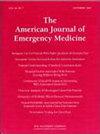Association between American Board of Emergency Medicine certification performance and severe state medical licensure actions
IF 2.7
3区 医学
Q1 EMERGENCY MEDICINE
引用次数: 0
Abstract
Background
Maintaining ABEM certification is associated with fewer state medical board disciplinary actions. To become ABEM-certified, candidates must pass the Qualifying Examination (QE) and then pass the Oral Certification Examination (OCE). The purpose of this study was to examine the relationship between certification examination performance and severe state medical board licensure actions for emergency physicians.
Methods
The sample was residency-trained emergency medicine physicians who graduated in 1973 or after and attempted to gain ABEM certification from 1979 to 2016. After excluding physicians who did not take the QE, graduated from non-categorical residency programs, or received a disciplinary action prior to graduation, 35,321 physicians remained. Severe actions were defined as actions that resulted in the denial, revocation, surrender, or suspension of a medical license. Severe actions data from 2021 and earlier were obtained from the NPDB. Analysis included descriptive statistics and Cox proportional hazard regression.
Results
Physicians were divided into three groups based on their performance on the QE and OCE. Group 1 physicians (30,058; 85.1 %) passed both examinations on their first attempt; Group 2 (4694; 13.3 %) passed the QE and OCE after multiple attempts on either or both exams; and Group 3 (569; 1.6 %) never passed either the QE or OCE.
There were 274 (0.9 %) physicians in Group 1 with severe actions; 96 (2.1 %) in Group 2; and 23 (4.0 %) in Group 3. Physicians in Group 1 had a lower rate of severe actions per 1000 person-years (0.52; 95 % CI, 0.46–0.59) than did physicians in Group 2 (1.02; 95 % CI, 0.81–1.22) or Group 3 (1.88; 95 % CI, 1.11–2.65). Compared to Group 1, Group 2 had a hazard ratio (HR) of 1.81 (95 % CI, 1.44–2.29); and Group 3 had an HR of 3.19 (95 % CI, 2.08–4.89). Compared to Group 2, Group 3 had a HR of 1.86 (95 % CI, 1.18–2.94). Additionally, female physicians were less likely to have severe actions than male physicians (Χ2(1) = 12.7, P < 0.01) when excluding physicians with no reported sex.
Conclusion
Difficulty becoming ABEM-certified is associated with severe medical board licensure actions. Never achieving ABEM certification was associated with the highest risk of action.
背景获得 ABEM 认证可减少州医学委员会的纪律处分。要获得 ABEM 认证,考生必须通过资格考试 (QE),然后通过口试认证考试 (OCE)。本研究旨在考察急诊医师认证考试成绩与州医学委员会严重执照处罚之间的关系。方法样本为1973年或之后毕业并在1979年至2016年期间试图获得ABEM认证的经过住院医师培训的急诊医师。在排除未参加 QE、毕业于非分类住院医师培训项目或在毕业前受到纪律处分的医生后,剩下 35,321 名医生。严重处分的定义是导致拒绝、撤销、退还或暂停医疗执照的处分。2021 年及以前的严重处分数据来自 NPDB。分析包括描述性统计和考克斯比例危险回归。结果根据医生在 QE 和 OCE 中的表现将其分为三组。第 1 组医生(30,058 人;85.1%)首次参加考试就通过了这两项考试;第 2 组医生(4694 人;13.3%)在多次参加其中一项或两项考试后通过了 QE 和 OCE;第 3 组医生(569 人;1.6%)从未通过 QE 或 OCE。与第 2 组(1.02;95 % CI,0.81-1.22)或第 3 组(1.88;95 % CI,1.11-2.65)的医生相比,第 1 组医生的每千人年严重行为发生率(0.52;95 % CI,0.46-0.59)更低。与第 1 组相比,第 2 组的危险比 (HR) 为 1.81(95 % CI,1.44-2.29);第 3 组的危险比为 3.19(95 % CI,2.08-4.89)。与第 2 组相比,第 3 组的 HR 为 1.86(95 % CI,1.18-2.94)。此外,在排除未报告性别的医生后,女医生比男医生更不容易受到严重处罚(Χ2(1) = 12.7, P < 0.01)。从未获得 ABEM 认证与最高的处罚风险相关。
本文章由计算机程序翻译,如有差异,请以英文原文为准。
求助全文
约1分钟内获得全文
求助全文
来源期刊
CiteScore
6.00
自引率
5.60%
发文量
730
审稿时长
42 days
期刊介绍:
A distinctive blend of practicality and scholarliness makes the American Journal of Emergency Medicine a key source for information on emergency medical care. Covering all activities concerned with emergency medicine, it is the journal to turn to for information to help increase the ability to understand, recognize and treat emergency conditions. Issues contain clinical articles, case reports, review articles, editorials, international notes, book reviews and more.

 求助内容:
求助内容: 应助结果提醒方式:
应助结果提醒方式:


